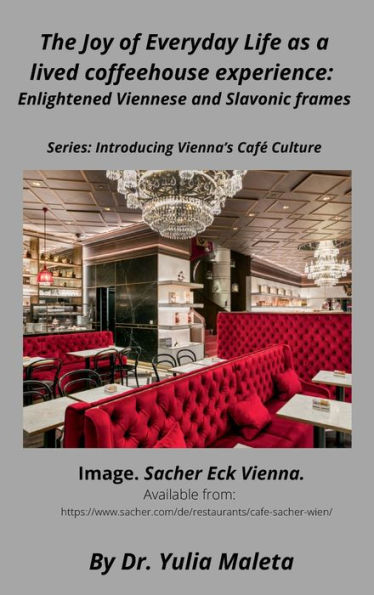The Joy of Everyday Life as a lived coffeehouse experience: Enlightened Viennese and Slavonic frames
In Book 3, I continue to illuminate Ringstrasse epoch coffeehouses- still shining today- mirroring Unesco's (2011) recognition of 'intangible cultural heritage', including: Café Landtmann (1873), the four Diglas cafes (1875), Café Central (1876), Café Sacher/ Hotel Sacher and Café Sperl (1880); likewise established during the mid-late 19th century of Ring redevelopment [Vienna's Second and Third Golden-Gilded Ages] (See Books 1 and 2). Following on from Books 1 and 2, I elaborate on the joy of everyday life as a lived coffeehouse experience through enlightened Viennese and Slavonic frames, exemplifying the joyful culture of coffee and cake- relative to my 3-step digestive plan. Arguably, Vienna's coffeehouses are framed by Slavic heritage and entrepreneurial leadership, relative to the omnipresent Slavonic 'joy de vivre' or 'joy in everyday life' (Maleta 2021; ibid 2022).
Regarding cafes: Landtmann, Diglas, Central, Sacher and Sperl, amongst other landmark coffeehouses, my Introductory Chapter presents a conceptual-methodological and pictorial/ illustrative analytical framework, focussing on these points: My 3-step: Sour-Savoury-Sweet plan; Research Context: Historic-modern frames. Vienna's 4 gilded/ golden ages; UNESCO: The Viennese coffeehouse as 'intangible cultural heritage'; Historicism and Ringstrasse development (1857-1914); Kolschitzky: Slavic-coffeehouse pioneer; My chronological articulation of core cafes; Café Sperl's Siebener C7 Club: West Slavic ties; Crediting Slavonic agentic competence; Sophia's patronage at Café Sperl; Women's entrepreneurial agency; The coffeehouse as a 'second living room'; and, An Overview to Book 3's Chapters. Markedly, in Book 3 (and my Series), I illuminate the integral diverse role of women as coffeehouse managers/proprietors, support staff and pastry chefs (Café Demel 2022a; Café Hawelka 2022c; Café Korb 2022a; Café Sacher 2022; Café Sluka 2022a; ibid 2022b; Hotel Sacher Vienna 2022d; Maleta 2021; ibid 2022; See Chapter 5).
1142995747
Regarding cafes: Landtmann, Diglas, Central, Sacher and Sperl, amongst other landmark coffeehouses, my Introductory Chapter presents a conceptual-methodological and pictorial/ illustrative analytical framework, focussing on these points: My 3-step: Sour-Savoury-Sweet plan; Research Context: Historic-modern frames. Vienna's 4 gilded/ golden ages; UNESCO: The Viennese coffeehouse as 'intangible cultural heritage'; Historicism and Ringstrasse development (1857-1914); Kolschitzky: Slavic-coffeehouse pioneer; My chronological articulation of core cafes; Café Sperl's Siebener C7 Club: West Slavic ties; Crediting Slavonic agentic competence; Sophia's patronage at Café Sperl; Women's entrepreneurial agency; The coffeehouse as a 'second living room'; and, An Overview to Book 3's Chapters. Markedly, in Book 3 (and my Series), I illuminate the integral diverse role of women as coffeehouse managers/proprietors, support staff and pastry chefs (Café Demel 2022a; Café Hawelka 2022c; Café Korb 2022a; Café Sacher 2022; Café Sluka 2022a; ibid 2022b; Hotel Sacher Vienna 2022d; Maleta 2021; ibid 2022; See Chapter 5).
The Joy of Everyday Life as a lived coffeehouse experience: Enlightened Viennese and Slavonic frames
In Book 3, I continue to illuminate Ringstrasse epoch coffeehouses- still shining today- mirroring Unesco's (2011) recognition of 'intangible cultural heritage', including: Café Landtmann (1873), the four Diglas cafes (1875), Café Central (1876), Café Sacher/ Hotel Sacher and Café Sperl (1880); likewise established during the mid-late 19th century of Ring redevelopment [Vienna's Second and Third Golden-Gilded Ages] (See Books 1 and 2). Following on from Books 1 and 2, I elaborate on the joy of everyday life as a lived coffeehouse experience through enlightened Viennese and Slavonic frames, exemplifying the joyful culture of coffee and cake- relative to my 3-step digestive plan. Arguably, Vienna's coffeehouses are framed by Slavic heritage and entrepreneurial leadership, relative to the omnipresent Slavonic 'joy de vivre' or 'joy in everyday life' (Maleta 2021; ibid 2022).
Regarding cafes: Landtmann, Diglas, Central, Sacher and Sperl, amongst other landmark coffeehouses, my Introductory Chapter presents a conceptual-methodological and pictorial/ illustrative analytical framework, focussing on these points: My 3-step: Sour-Savoury-Sweet plan; Research Context: Historic-modern frames. Vienna's 4 gilded/ golden ages; UNESCO: The Viennese coffeehouse as 'intangible cultural heritage'; Historicism and Ringstrasse development (1857-1914); Kolschitzky: Slavic-coffeehouse pioneer; My chronological articulation of core cafes; Café Sperl's Siebener C7 Club: West Slavic ties; Crediting Slavonic agentic competence; Sophia's patronage at Café Sperl; Women's entrepreneurial agency; The coffeehouse as a 'second living room'; and, An Overview to Book 3's Chapters. Markedly, in Book 3 (and my Series), I illuminate the integral diverse role of women as coffeehouse managers/proprietors, support staff and pastry chefs (Café Demel 2022a; Café Hawelka 2022c; Café Korb 2022a; Café Sacher 2022; Café Sluka 2022a; ibid 2022b; Hotel Sacher Vienna 2022d; Maleta 2021; ibid 2022; See Chapter 5).
Regarding cafes: Landtmann, Diglas, Central, Sacher and Sperl, amongst other landmark coffeehouses, my Introductory Chapter presents a conceptual-methodological and pictorial/ illustrative analytical framework, focussing on these points: My 3-step: Sour-Savoury-Sweet plan; Research Context: Historic-modern frames. Vienna's 4 gilded/ golden ages; UNESCO: The Viennese coffeehouse as 'intangible cultural heritage'; Historicism and Ringstrasse development (1857-1914); Kolschitzky: Slavic-coffeehouse pioneer; My chronological articulation of core cafes; Café Sperl's Siebener C7 Club: West Slavic ties; Crediting Slavonic agentic competence; Sophia's patronage at Café Sperl; Women's entrepreneurial agency; The coffeehouse as a 'second living room'; and, An Overview to Book 3's Chapters. Markedly, in Book 3 (and my Series), I illuminate the integral diverse role of women as coffeehouse managers/proprietors, support staff and pastry chefs (Café Demel 2022a; Café Hawelka 2022c; Café Korb 2022a; Café Sacher 2022; Café Sluka 2022a; ibid 2022b; Hotel Sacher Vienna 2022d; Maleta 2021; ibid 2022; See Chapter 5).
84.0
In Stock
5
1

The Joy of Everyday Life as a lived coffeehouse experience: Enlightened Viennese and Slavonic frames
288
The Joy of Everyday Life as a lived coffeehouse experience: Enlightened Viennese and Slavonic frames
288Hardcover
$84.00
84.0
In Stock

Product Details
| ISBN-13: | 9798823183536 |
|---|---|
| Publisher: | Barnes & Noble Press |
| Publication date: | 01/22/2023 |
| Series: | Introducing Vienna's Café Culture , #3 |
| Pages: | 288 |
| Product dimensions: | 6.00(w) x 9.00(h) x 0.69(d) |
About the Author
From the B&N Reads Blog
